Almost opposite this Wetherspoon pub is the former Malt Cross Music Hall. Built in 1877, the music hall occupied the site of the Malt Cross public house, originally The Roebuck, first recorded in 1760.
Prints and text about The Roebuck Inn.
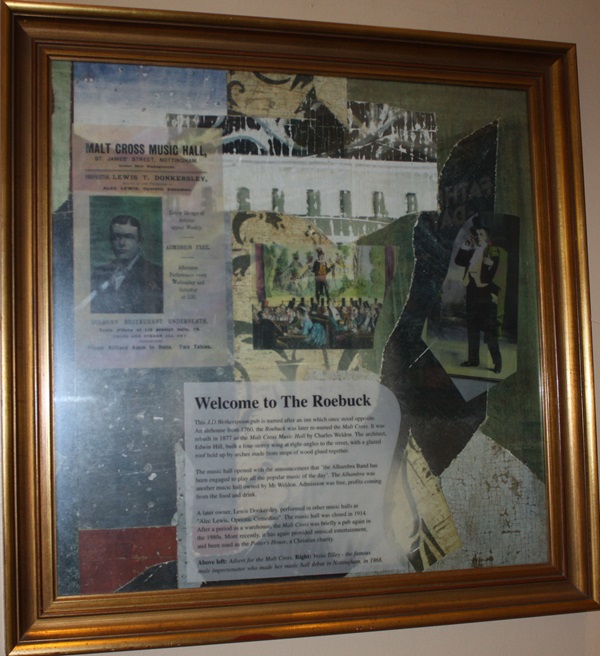
The text reads: This J.D. Wetherspoon pub is named after an inn which once stood opposite An alehouse from 1760, the Roebuck was later re-named the Malt Cross. It was rebuilt in 1877 as the Malt Cross Music Hall by Charles Weldon. The architect, Edwin Hill, built a four-storey wing at right-angles to the street, with a glazed roof held up by arches made from strips of wood glued together.
The music hall opened with the announcement that "the Alhambra Band has been engaged to play all the popular music of the day". The Alhambra was another music hall owned by Mr Weldon. Admission was free, profits coming from the food and drink.
A later owner, Lewis Donkersley, performed in other music halls as "Alec Lewis, Operatic Comedian". The music hall was closed in 1914. After a period as a warehouse, the Malt Cross was briefly a pub again in the 1980s. More recently, it has again provided musical entertainment, and been used as the Patter's House, a Christian charity.
Above left: Advert for the Malt Cross
Right: Vesta Tilley - the famous male impersonator who made her music hall debut in Nottingham, in 1868.
Prints and text about St James’ Street.
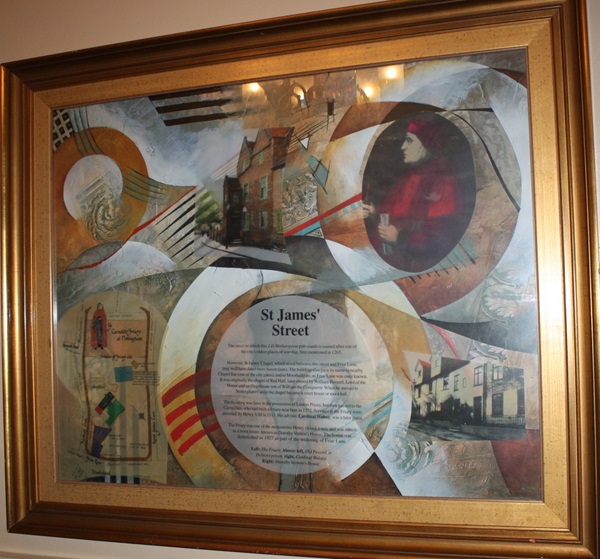
The text reads: The street in which this J.D. Wetherspoon pub stands is named after one of the city's oldest places of worship, first mentioned in 1265.
However, St James' Chapel, which stood between this street and Friar Lane, may well have dated from Saxon times. The building also gave its name to nearby Chapel Bar (one of the city gates), and to Moothallgate, as Friar Lane was once known. It was originally the chapel of Red Hall, later owned by William Peverel, Lord of the Manor and an illegitimate son of William the Conqueror. When he moved to Nottingham Castle the chapel became a court house or moot hall.
The building was later in the possession of Lenton Priory, but then passed to the Carmelites who had built a Friary here in 1272. Services at the Friary were attended by Henry VIII in 1511. His Services adviser Cardinal Wolsey, was a later guest.
The Friary was one of the monasteries Henry closed down, and was rebuilt a town house, known as Dorothy Vernon's House. The house was demolished in 1927 as part of the widening of Friar Lane.
Left: The Friary
Above: left, Old Peverel or
Debtors prison, right, Cardinal Wolsey
Right: Dorothy Vernon's House.
Prints and text about Maid Marian.
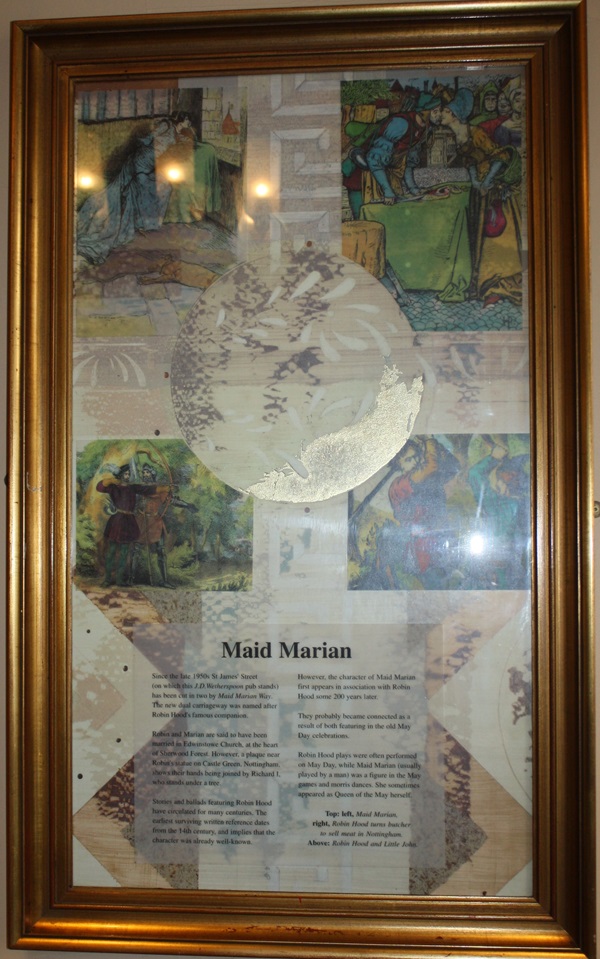
The text reads: Maid Marian Since the late 1950s St James' street (on which this JD Wetherspoon pub stands) has been cut in two by Maid Marian Way, The new dual carriageway was named after Robin Hood's famous companion,
Robin and Marian are said to have been married in Edwinstowe Church, at the heart of Sherwood Forest. However, a plaque near
Robin's statue on Castle Green, Nottingham,
shows their hands being joined by Richard I, who stands under a tree.
Stories and ballads featuring Robin Hood have circulated for many centuries. The earliest surviving written reference dates from the 14th century, and implies that the character was already well-known.
However, the character of Maid Marian first appears in association with Robin Hood some 200 years later.
They probably became connected as a result of both featuring in the old May Day celebrations.
Robin Hood plays were often performed on May Day, while Maid Marian (usually played by a man) was a figure in the May games and morris dances. She sometimes appeared as Queen of the May herself.
Top: left, Maid Marian,
right, Robin Hood turns butcher to sell meat in Nottingham
Above: Robin Hood and Little John.
Prints and text about the Mechanics’ Institute.
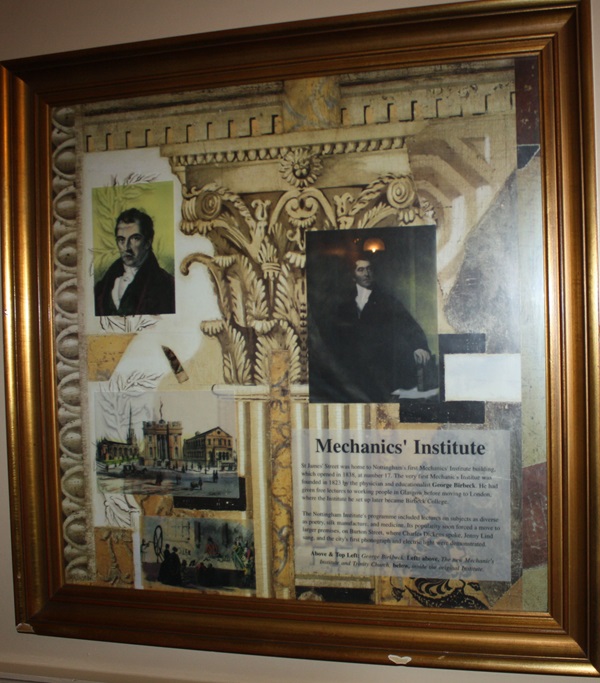
The text reads: St James Street was home to Nottingham's first Mechanics’ Institute building, which opened in 1838, at number 17. The very first Mechanic’s Institute was founded in 1823 by the physician and educationalist George Birbeck. He had
given free lectures to working people in Glasgow before moving to London, where the Institute he set up later became Birbeck College.
The Nottingham Institute programme included lectures on subjects as diverse as poetry, silk manufacture and medicine. Its popularity soon forced a move to larger premises, on Burton Street, where Charles Dickens spoke, Jenny Lind sang, and the city’s first phonograph and electric light were demonstrated.
Above & top left: George Birkbeck
Left: above, The new Mechanic's Institute and Trinity Church, below, inside the original Institute.
Prints and text about the Malt Cross.
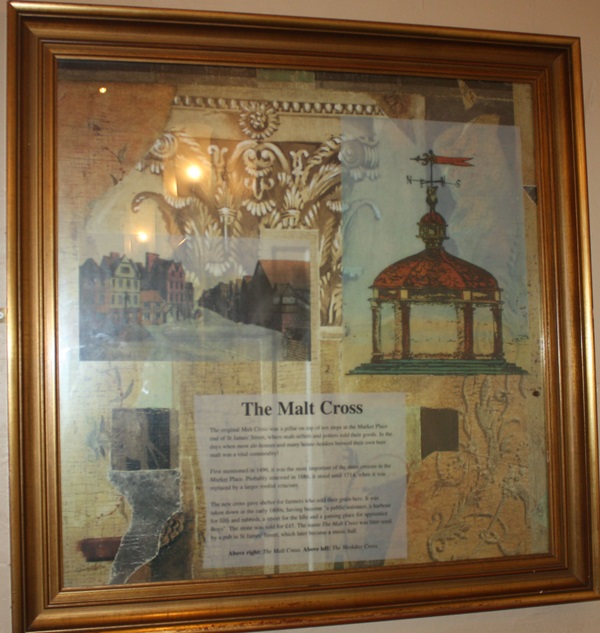
The text reads: The original Malt Cross was a pillar on top of ten steps at the Market Place end of St James' Street, where malt-sellers and potters sold their goods. In the days when most ale-houses and many house-holders brewed their own beer malt was a vital commodity!
First mentioned in 1496, it was the most important of the three crosses in the Market Place. Probably renewed in 1686, it stood until 1714, when it was replaced by a larger roofed structure.
The new cross gave shelter for farmers who sold their grain here. It was taken down in the early 1800s, having become "a public nuisance, a harbour for filth and rubbish, a resort for the Idle and a gaming place for apprentice Boys". The stone was sold for £45. The name The Malt Cross was later used by a pub in St James’ Street, which later became a music hall.
Above right: The Malt Cross Above left: The Weekday Cross.
Prints, photographs and text about the history of Nottingham.
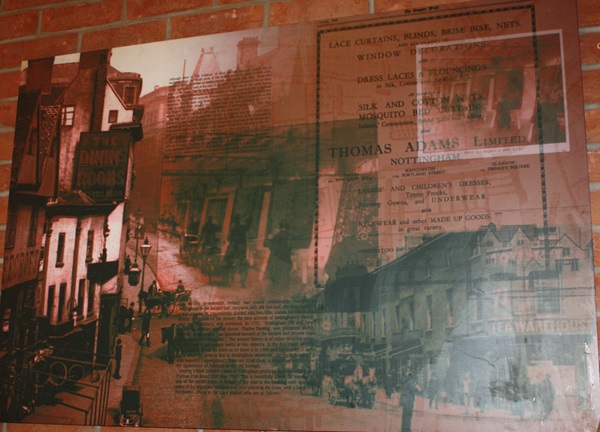
The text reads: Although there is little evidence of what the old borough looked like in medieval times, no doubt most of the houses would be fairly modest ones, probably made of timber or timber-framed with wattle and daub. Some idea of the appearance, and of the rest of the town, can be obtained from an early map of the town, that by John Speed in 1610. This shows the street layout and a pictorial representation of the houses on each street is given. It appears that in the Lace Market area the houses stretched along both side of the streets between Fletcher Gate and Stoney Street, with open space or gardens at the rear. A rather more detailed and clearer map was that published in 1677 in Dr. Robert Thoroton's book The Antiquities of Nottinghamshire'. This map shows that there was little difference in the area since 1610.
The first half of the seventeenth century in England was not a particularly prosperous one, with the political and religious differences of the Stuart period culminating in the Civil Wars and the temporary abolition of the monarchy. Nottingham shared in the troubles this caused. lt had been thriving in the two centuries proceeding this time, as witnessed by the completion of St Mary's church in the fifteenth century. This was made possible by the wealth created by the wool trade and the benefactions of a number of prosperous merchants such as Thomas Thurland. By the early part of the seventeenth century this trade had been superseded by cloth making in parts of the country. The castle too had ceased to have royal status and the building itself was decaying. The disruption caused by the Civil Wars could not have helped Nottingham’s economy.
Just as the seventeenth century had meant considerable changes in Nottingham in the second half compared with the first half, the next hundred years can also be conveniently divided into the two. One reason for this is that around the middle century the next account of Nottingham’s history, after Dr. Thoroton’s, was published. In 1751, ‘Nottingham Old and New’ written by another medical doctor, Charles Deering, was published shortly after his death to give ‘an historical account of the ancient and present state of the town of Nottingham’. The ancient history is of rather doubtful value, but the book is particularly useful in two respects. In the first place, Deering has written about the town as he knew it in 1749 and had known it since 175 when he came to live in Nottingham. Moreover the book is ‘adorned with beautiful copper plates’. There are 32 of these, a number which show the appearance of buildings in the old borough.
Deering’s book included a plan of Nottingham produced by John Badder and Thomas Peat dated 20th May 1744. This is beautifully drawn far superior to any of the earlier maps. A feature of the plan is the marking with numbers, some of the most important building and other places in the town, with a list giving the names.
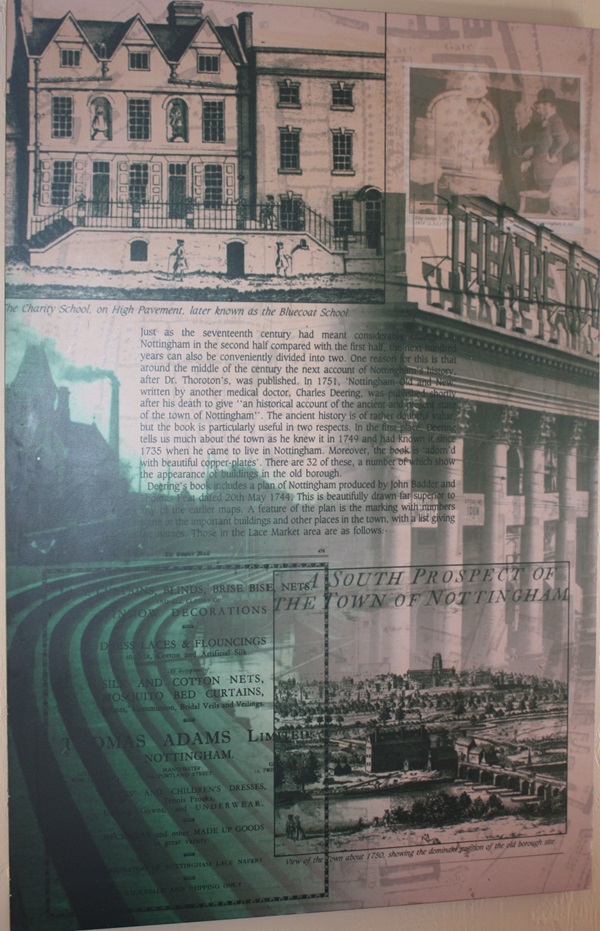
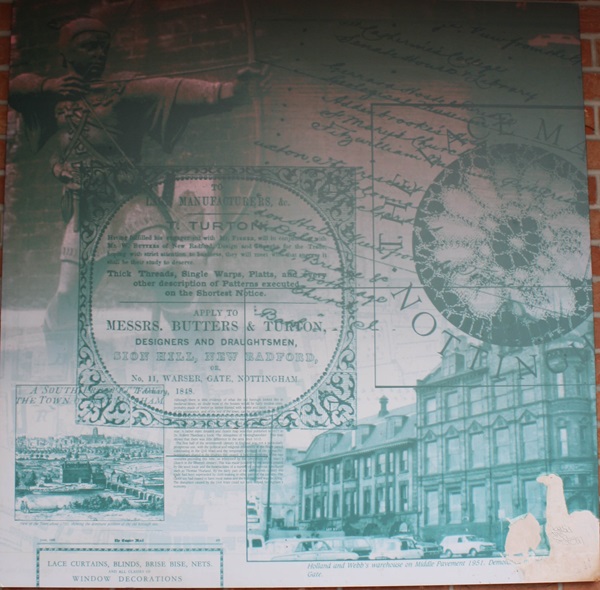
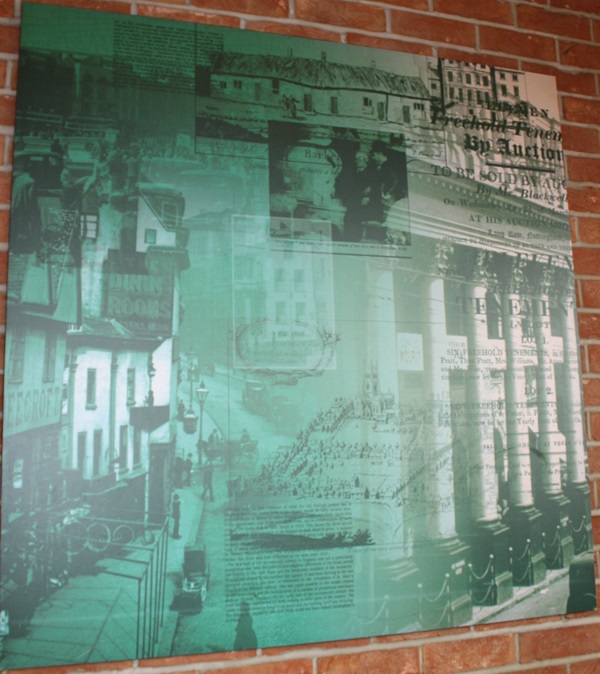
Prints of Nottingham.
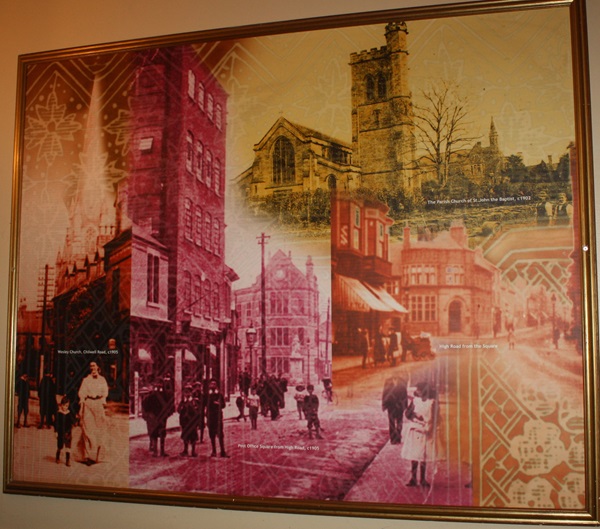
Left: Wesley Church, Chillwell Road, c1905
Middle: Post Office Square from High Road
Bottom right: High Road from the Square
Top right: The Parish Church of St John the Baptist, c1902.
Photographs and text about Nottingham Castle.
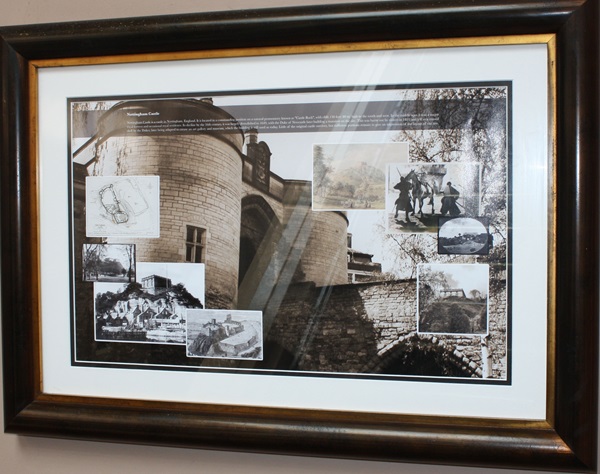
The text reads: Nottingham Castle is a castle in Nottingham, England. It is located in a commanding position on a natural promontory known as “Castle Rock”, with cliffs 130 feet (40m high) to the south and west. In the middle ages it was a major royal fortress and occasional royal residence. In decline by the 16th century, it was largely demolished in 1649, with the Duke of Newcastle later building a mansion on the site. This was burnt out by rioters in 1831 and left as a ruined shell by the Dukes; later being adapted to create an art gallery and museum, which the building is still used as today. Little of the original castle survives, but sufficient portions remain to give an impression of the layout of the site.
Photographs and text about Raleigh Bicycle Company.
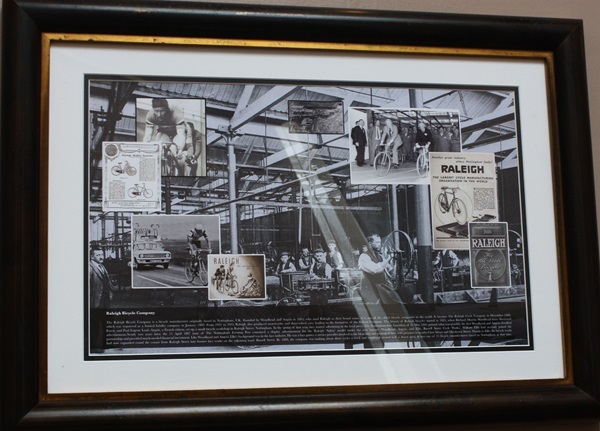
The text reads: The Raleigh Bicycle Company is a bicycle manufacturer originally based in Nottingham, UK. Founded by Woodhead and Angois in 1885, who used Raleigh as their brand name, it is one of the oldest bicycle companies in the world. It became The Raleigh Cycle Company in December 1888, which was a registered liability company in January 1889. From 1921 to 1935 Raleigh also produced motorcycles and three-wheeled cars leading the formation of the Reliant Company. The history of Raleigh Bicycles started in 1885, when Richard Morris Woodhead from Sherwood Forest, and Paul Eugene Louis Angois, a French citizen, set up a small bicycle workshop in Raleigh Street, Nottingham. In the spring of that year, they started advertising in the local press. The Nottinghamshire Guardian of 15 May 1885 printed what was possibly the first Woodhead and Angois classified advertisement. Nearly two years later, the 11 April 1887 issue of the Nottingham Evening Post contained a display advertisement for the Raleigh ‘Safety’ model under the banner ‘Woodhead, Angois and Ellis Russel Street Cycle Works’. William Ellis had recently joined the partnership and provided much-needed financial investment. Like Woodhead and Angois, Ellis’ background was in the lace industry. He was a lace gasser, a service provider involved in the bleaching and treating of lace, with premises in nearby Clare Street and Glasshouse street. Thanks to Ellis, the bicycle works had now expanded round the corner from Raleigh Street into former lace works on the adjoining road, Russel street. By 1888, the company was making about three cycles a week and employed around half a dozen men. It was of 15 bicycle manufacturers based in Nottingham at the time.
An illustration of The Castle, Nottingham.
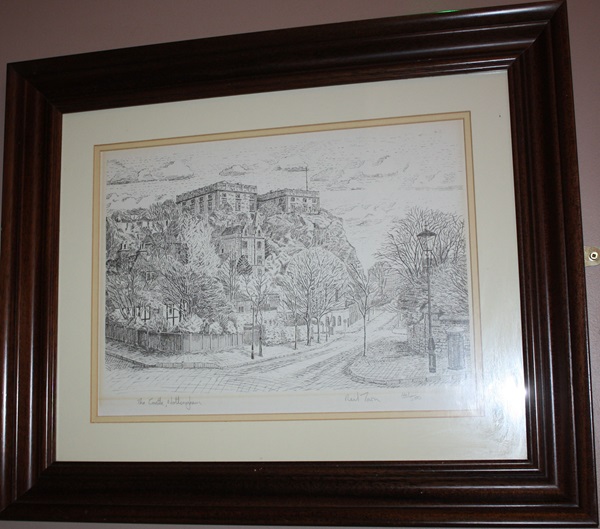
External photograph of the building – main entrance.
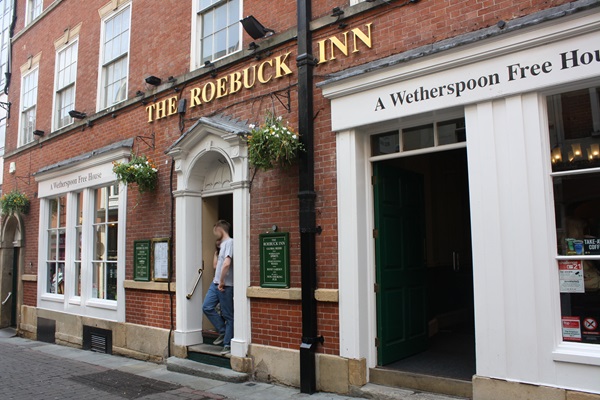
If you have information on the history of this pub, then we’d like you to share it with us. Please e-mail all information to: pubhistories@jdwetherspoon.co.uk